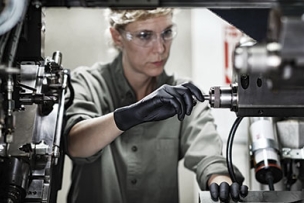SHOWA is synonymous with the highest degree of hand protection and innovation. With 58 patents owned and hundreds of researchers and developers dedicated to making our best even better, we lead our industry without imitation. Our revolutionary technology is embedded in over 1,800 gloves, each meticulously engineered to provide the ideal protection for the task at hand. Down to every fiber, our gloves are created better to perform better, unleashing new potential for hands at work.
The use of single-use gloves has exploded in the wake of the surging pandemic. However, sustainable solutions are needed to tackle the growing volume of waste. Back in 2012, SHOWA launched the first single-use biodegradable gloves. Since then, the market has seen a host of new models from the competition, each with their own set of claims. As a fully integrated manufacturer, SHOWA believes that it is important to bring greater clarification to this particular market segment.
When you hear that a glove is biodegradable, you need to consider whether the glove will achieve a high level of degradability under controlled conditions. How fast will the glove degrade? Under which conditions? Will biodegradability affect the glove’s shelf life or efficiency?
SHOWA has listed five factors that you should consider when looking to switch to single-use biodegradable gloves.
1. Speed of biodegradation
Two methods must be used when it comes to comparing the speed of biodegradation.
Aerobic biodegradability
This type of biodegradability can be achieved under controlled composting conditions. As specified in ISO 14855-1, this method is designed to simulate typical aerobic composting conditions for the organic fraction of solid mixed municipal waste. The composting takes place in an environment wherein temperature, aeration and humidity are closely monitored and controlled. The test method is designed to yield the percentage conversion of the carbon in the test material to evolved carbon dioxide as well as the rate of conversion. In other words, this test method shows how much of the glove’s carbon content is transformed into CO2, which is expressed as a percentage, and the rate of conversion.
Anaerobic biodegradability
Contrary to aerobic biodegradability, anaerobic biodegradability refers to the degradation of compounds by microorganisms in the absence of oxygen. Microorganisms use a chemical other than oxygen as an electron acceptor. SHOWA uses this process to define how much their EBT (Eco Best Technology) accelerates biodegradability.
They strongly advise you to check out the method used to determine the speed of biodegradability.
2. Physical and chemical resistance properties
To the best of SHOWA's knowledge, biodegradable gloves can be composted if the nitrile molecule chains are not overly crosslinked or not crosslinked at all. This balance will define the speed of degradation.
The main concern with an excessive speed is how the glove’s physical and chemical resistance properties will be affected. The physical and chemical properties of a glove with a high biodegradation speed in aerobic composting (e.g. > 80% within 90 days) will probably be less effective. Air and moisture affect durability. Even storage conditions could affect the initial performance of the glove.
Fast biodegradable gloves could also have a lower level of tear resistance. European standard EN 455 comprises four parts and will help you define what you are looking for in a single-use glove. Part 1 specifies the requirements and provides methods for testing single-use medical gloves to determine freedom from holes (resistance to penetration). Part 2 addresses the physical properties of disposable gloves, including tear resistance (force at break). Part 3 provides requirements for labelling and the evaluation of biological safety. Finally, Part 4 provides requirements for determining the product’s shelf life under normal storage conditions.
3. Economic utility
Biodegradability should help generate energy.
During biodegradation, the glove releases methane (CH4). This gas can be captured in a controlled landfill and transformed into energy (like the methane captured in biogas plants). In biogas plants using organic agricultural waste, and sometimes municipal waste, the aerobic digestion process only lasts for a few days or weeks under anaerobic conditions. This time span might be too short for a “compostable” glove to fully biodegrade, meaning that the methane (CH4) cannot be “extracted” in comparable quantities compared to biodegradation in a landfill, so the economic utility of a “compostable” glove is lower or cannot be exploited.
4. No possible allergies
With less than 1% of the general population allergic to natural rubber, the probability of people experiencing an allergic reaction to the offending protein when wearing single-use gloves is low. However, to avoid even the slightest risk of an allergic reaction, the best course of action is to go for a 100% nitrile disposable glove.
5. GreenCircle certification
With ever more nitrile gloves entering the market, and because sustainability is one of SHOWA's top priorities, they developed their Eco Best Technology and also obtained GreenCircle certification.
GreenCircle certification demonstrates to customers that they are making efforts to be sustainable. Following a GreenCircle audit, eight of SHOWA's gloves were certified.
Previously Featured on SHOWA's blog.
Browse MSCDirect.com to see a variety of SHOWA's gloves to find the right one for your application.








Talk to Us!
Leave a reply
Your email address will not be published. Required fields are marked *